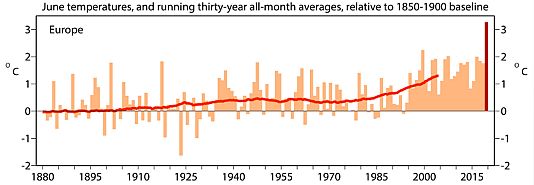“But when is it going to end?” a user was asking two months ago on Reddit, an informal forum-style social media platform. The “Heatwave in Europe” conversation had gained over 800 comments from people across the world, many appalled by the scorching June and July 2019 temperatures on the continent. “Although local temperatures may have been lower or higher than forecast, our data shows that the temperatures over south-western Europe in the last week of June were unusually high. Although this was exceptional, we are likely to see more of these events in the future due to climate change,'' says Jean-Noël Thépaut, Head of Copernicus Climate Service (C3S). Comparing recent C3S data with older records shows that this year’s June was on average 3°C warmer than the average for 1850-1900.
The World Weather Attribution initiative stated that such record temperatures would usually occur every 50 to 150 years. But, according to the European Environment Agency, Europe has experienced several extreme heat waves every year since 2014 except in 2016, putting emergency teams on their toes, infrastructure out of order and raising flags on how fast Europe can adapt to extreme weather.
A big challenge for European urban areas
With about 76% of the EU’s population living in cities and expected to increase to 82% by mid-century, much of the adaptation will have to happen in cities.
In the last three months, a flood of media reports pointed to how extreme heat struck the core issues of urban life in Europe, from homes to public transportation, utilities, and businesses, all the way to the health of those most vulnerable. Rethinking infrastructure and how cities function under heat might pave the way to resilience, as many urban areas on the continent prepare for their hotter future.
Overheating rails and coaches, a public transportation confusion
It was past noon on July 25 when French train operator SNCF tweeted that more than half the trains linking the city of Metz to Luxembourg – a popular commute – broke down because of the heat. On the same day, Paris train line RER A, serving about 50,000 people every hour during peak times, pulled the breaks on their trains, as temperatures exceeding 40°C threatened rails and overhead cables. In the UK, several heat-related incidents altered National Rail services, while the London Overground suffered major disruptions during rush hour. Three days later two rails in Sweden buckled under the heat.
Slow-motion in the cities might become the norm on hot days. Complaints by the hundreds flowed on public transport companies’ social media accounts, as the laws of physics were running their course. “As they heat up – getting to temperatures about 20°C higher than the air – steel rails expand, increasing the rail length, which could lead to curving, known also as buckling,” explains Dr John Easton, rail expert at the Institution of Engineering and Technology. Adjusting for higher temperatures could “certainly increase the risk of rail brakes,” says Dr Easton. “The only solution is to slow trains down.”
Painting the rails white to reflect some of the light has also been used as a popular option to drop their temperature by 5-10°C. But keeping passengers cool is on top of the list for longer-term solutions. France’s SNCF is testing new A/C systems for train coaches and low-emission climatisation systems, while Transport for London’s Four Lines Modernisation has provided 192 new air-conditioned trains for Londoners.
Heatwaves pushing power plants to breaking point
With industry, businesses and households in cities heavily reliant on power, urban economies and lifestyle can be hit without further adaptation. On June 27, in a Milan sweating at over 40°C, the city’s electricity demand peaked at 1635 MW. Several blackouts left parts of Italy’s financial capital powerless, some for more than half a day, as demand soared by 40% more than the previous year.
In summer, Athens doubles its cooling demand, which leads to a tripling of peak electricity loads. Meanwhile, the European Environment Agency says that peak electricity demand for cooling will increase in Europe, predicting the largest boost for Italy, Spain, and France. In Italy for example, demand for cooling for households and services might go from 13% of total primary energy demands in 2010 to 70% in 2050,
But with 66% of the EU’s heating and cooling energy provided by fossil fuels, and an estimated 60.5 million room air conditioning units in 2016, cooling down might pump up the heat even more.
As hotter air will demand more cooling, energy production needs to keep up. But unusually high temperatures, especially when it comes to fossil fuel and nuclear-based energy, can also slow down energy output. On the morning of the hottest day in France, EDF reduced energy output in six reactors; it had already shut down two others south of the country, where the Garonne river’s waters were too warm to cool down reactors.
Power line distribution less efficient in excessive heat as AC demand soars
Europeans are also expected to want to be cooler in their homes. As demand for cooling increases and more energy must pass through the wires in high temperatures, the lines tend to swell and sag, leading to potential faults in the infrastructure. Studies in the U.S. showed that for every degree of warming in the summer, power lines lose about 1.5% of their transmission capacity, which can become an energy security problem when demand for cooling peaks. In the UK, operators are using cables in-built with more heat tolerance, while Finland is moving cables underground.
Although in 2018, the EU accounted for 11% of the global cooling energy consumption – which includes refrigerators and mobile cooling, such as mobile AC units and fans – the energy used to cool buildings across Europe is likely to increase by 72% by 2030, say experts from the International Renewable Energy Agency.
More efficient A/C units, increasing transmission capacity and shifting to energy sources that don’t require cooling water, such as solar PV can make a difference. Alternatives such as heat-driven absorption cooling and better building design can also reduce cooling needs, the EEA says.
Hotter urban heat islands
Only two nights between June 21 and August 22 weren’t tropical in Nice this summer – with temperatures below 20°C – according to Météo France, breaking another urban record. The inability of temperatures to go down in cities at night is part of the urban heat island effect, as buildings and sealed surfaces trap and re-radiate more heat at night into the city’s air than rural and green areas do.
“Helping people with higher exposure to heat is crucial,” says the expert team at the Barcelona Lab for Environmental Justice and Sustainability (BCNUEJ). “Low-income residents tend to live in housing conditions with poorer cooling or insulation infrastructure, have fewer means to upgrade their homes, and live in neighbourhoods with fewer trees and large green spaces.”
“We need to plant trees where the heat island effect is higher, where people are suffering, especially in the grey areas of the peripheries,” says Piero Pelizzaro, Chief Resilience Officer for the City of Milan. “When you are middle class, you can manage the heatwave, you buy air conditioning. If you are poor, you’ll suffer more. The inequality is increasing so it’s increasing the so-called climate gentrification. In Milan, this is getting worse.” Milan’s mayor office aims to plant 3 million trees by 2030 in the city’s metropolitan area, through an Urban Forest Programme, Pelizzaro explains. Almost 80,000 trees have been planted in the first year.
Europe’s cities, health issue hotspots?
The heat-amplifying effect of cities and more frequent heatwaves will expose the EU’s urban population to overheating during summer months, already a health emergency according to recent reports. The 70,000 deaths associated with the August 2003 European heatwave have determined many local authorities across the continent to get prepared. Paris’ Adaptation Plan relies on people to take care of their neighbours and register those vulnerable to heat to be monitored during peak temperature days. To catch up on its green spaces and tackle the UHI effect, the capital also launched the OASIS project, renovating schoolyards to replace asphalt with porous materials and increase green and cooling areas. “What makes the program innovative is its governance, which brought together different city departments (schools, health, roads, green spaces, and water) to design and deliver the project in an integrated manner,” says Lina Liakou, 100 Resilient Cities Network managing director.
High temperatures in urban areas can also increase exposure to ground-level ozone – harmful to people’s respiratory and cardiac systems and causing premature deaths - which develops when nitrous oxides and volatile compounds emitted from human activities react under high sunlight and temperatures. During the last June heatwave, some European cities had ozone levels of about 180 µg/m³, the maximum EU limit. In 2016, about 98% of the EU’s urban population was still exposed to ground-level ozone values above WHO limits.
Copernicus to help cities with adaptation
With the biggest climate data bank available through its fully operational Climate Data Store, or by developing solutions in partnership with research and technology companies or local authorities, Copernicus Climate Change Service (C3S) is developing climate indicator tools to help city authorities respond to the health challenges associated with heatwaves.
For more than six months, it has been working with Belgium-based VITO to produce high-resolution data that can be used for adaptation strategies in city planning and preventive health care. The high-resolution data will provide a snapshot of temperature distribution and other climate variables for about 100 cities across Europe, focusing on heat islands.
The VITO-led initiative uses simplified models, taking into consideration how different buildings and land surfaces respond to heat and radiation: along with increased vegetation and nature-based solutions, city planners can reduce the impact of heatwaves by changing the colour of buildings or applying white roofing, which reflects – rather than absorbs – solar radiation. The geometry of buildings can also be modified to avoid the warming effect of urban canyons. “If you want to develop an effective adaptation strategy, you need to know which parts of the city are most likely to be affected and then put some offsetting factors in place,” says Carlo Buontempo, Manager of the C3S Sectoral Information System.
Another Copernicus C3S initiative is to launch an operational service for the energy sector to help prevent major power disruptions in the future. As Carlo Buentempo says, “We need to predict how the energy mix can meet future demand while taking into consideration that the patterns of both renewable production and energy demand are likely to change in response to climate change.”







